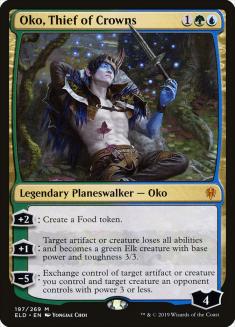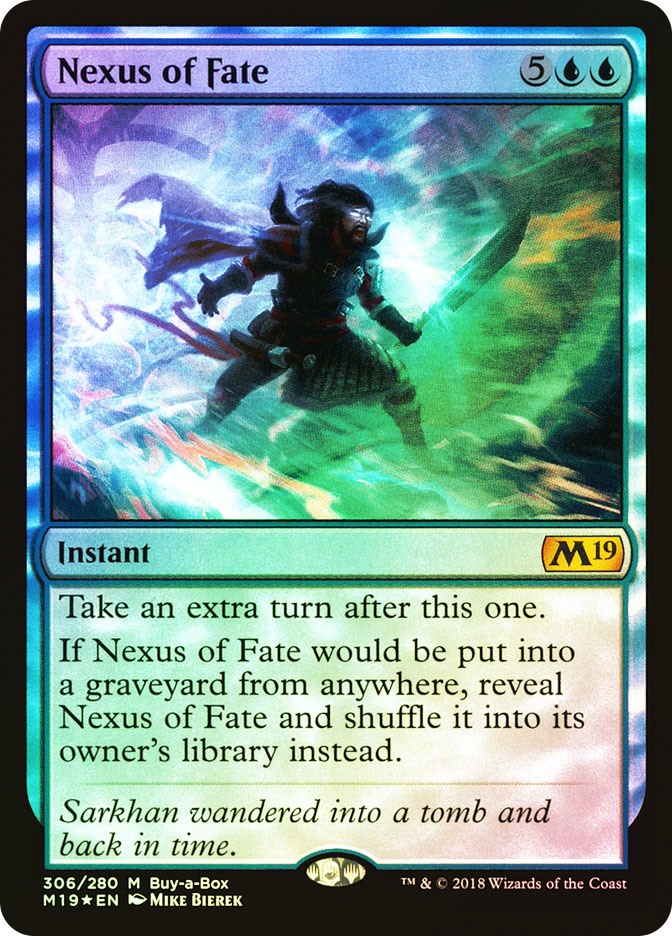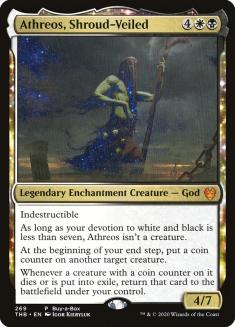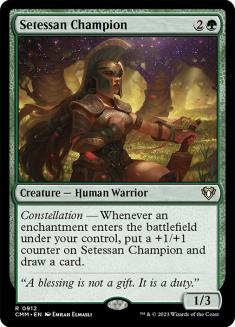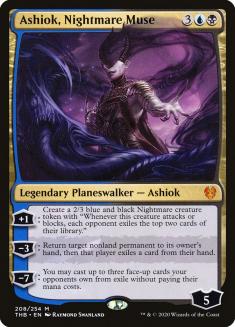Welcome to another edition of Fact or Fiction! Today, Cedric Phillips, Shaheen Soorani, and Sam Black are here to give their takes on five statements about the December 16th Pioneer Banned & Restricted Announcement and Theros Beyond Death. Don’t forget to vote for the winner at the end!
1. Banning Oko, Thief of Crowns in Pioneer was a good decison.
Cedric Phillips: Fact. A few quick notes…
I covered Mythic Championship V, where Simic Food was one of the most played decks (though the tournament was won by Javier Dominguez playing Gruul Aggro). I played in Mythic Championship VI, where Simic Food was far and away the best deck (so good, in fact, that I had no choice but to play it just like the majority of the field). I covered the Players’ Championship last weekend, where Oko ran rampant in the Modern and Legacy portions of the tournament. I played a game at GP Columbus with Humans against Simic Whirza where I cast or copied Deputy of Detention five times and did not get even close to winning because 1/3s do nothing against 3/3s.
I never want to see someone cast an Oko again. Ever. Not only was this a good decision, it was the best and only decision. Ban this stupid card in all formats, remove it from all Cubes, shame anyone who puts it into their Cube, and burn the shirt they gave everyone at Mythic Championship VI (a shirt with a big picture of Oko on it because… duh) and let’s just all collectively forget that this ever happened.
Shaheen Soorani: Fact. I think it’s time we all accept that Oko, Thief of Crowns belongs in zero competitive formats. The fans of Cube and Vintage will forever have access to the best planeswalker of all time, but that’s where the line must be drawn. Although it hasn’t broken Pioneer yet, it does lead to some very homogeneous gameplay and deck building.
There are some that really enjoy turning every control, midrange, and combo deck into Simic-based; however, that is not what is best for the flourishing new format. We all were told that our favorite new format was going to undergo heavy changes before settling. This weekly update is harsh and will take away many archetypes that we hold near and dear to our heart. Oko, Thief of Crowns will eventually be ousted from Modern (and probably Legacy), so be prepared.
Sam Black: Fact. I don’t really know how to get into this with original words. If you watched coverage of the Players’ Championship, you know that by the end of the tournament, Patrick would just laugh and say, “[Oko’s] a good card” because you can only say so many original things about it. Oko’s too strong and invalidates too many fun and interesting cards and strategies. Its ubiquity would never stop being a problem, and neither would its win percentage. I still don’t expect it to make it to 2021 in Modern.
2. Banning Nexus of Fate in Pioneer was a good decision.
Cedric Phillips: Fiction. This is probably the Spike in me but Nexus of Fate hasn’t ever really bothered me. It requires quite a bit of assembly to get it up and running and the true offender in Simic Nexus or other Nexus combo decks is Wilderness Reclamation, not the seven-mana blue instant. I get that it’s annoying to never get a turn again once the ball gets rolling but it’s pretty easy to prey on Nexus of Fate strategies and the card doesn’t do much of anything on its own.
Weirdly, I like comparing Nexus of Fate to Teferi, Hero of Dominaria because once you reach your desired game state with either card (emblem with Teferi versus infinite turns with Nexus), the play experience is horrible for the person on the receiving end of it. The difference here, however, is that Teferi costs two less mana and is very good while Nexus is seven mana and is pathetic by itself. Yet no one ever talks about banning Teferi, something I’ve always found to be a bit strange because I think playing against the card is absolutely miserable yet has quite a few similarities to playing against Nexus.
Long story short, I wouldn’t have banned Nexus because it hasn’t done enough to warrant such an extreme action and I don’t think it’s that hard to beat if you want to.
Shaheen Soorani: Fact. Another mistake in printing, Nexus of Fate, joins the Banned List with very few people mourning its loss. Excruciating gameplay is something that best describes it, marking one of the reasons why Krark-Clan Ironworks is no longer legal in Modern. It does a lot of wheel spinning, prompting an opponent to concede when they’ve lost enough turns, or keeps the competitive playing until the win condition reveals itself.
In Pioneer, Nexus of Fate decks have a much more consistent way of showing the opponent that the game is indeed over. This is of course thanks to Dig Through Time, which could have been banned instead. I’m ecstatic that they chose the former because Dig Through Time is the backbone for control decks in Pioneer. In this case, the win condition was axed instead of the enabler, which is perfectly fine by me. Cards like Nexus of Fate, Sensei’s Divining Top, and Krark-Clan Ironworks all provide a solitaire element that can perpetuate indefinitely. They may not be broken, but they offend the spirit of the game.
Sam Black: Fact. This one’s not as clear-cut, but the card is absolutely miserable, and speaking from the experience of playing Pioneer Leagues on Magic Online, I was definitely getting tired of how often I was playing against Simic combo decks. If WotC’s data supported that Nexus was beating most non-Oko decks, I’d certainly hate to play the format where there was more of that deck and it was better.
Moreover, it’s the kind of card that just isn’t doing any good in the format. It’s not creating diversity because there’s basically one right way to play it, so it creates a single deck. Yes, a format is more diverse with one extra deck rather than not, but I believe that deck would have pushed several other decks out of the format.
As always, the logistics both of the card’s printing and of the physical mechanics of executing a win that involves dozens of shuffles in paper or several minutes of solitary game actions online further cements the case for removing it from the format.
3. You’re excited about returning to the world of Theros, where devotion and constellation are key mechanics.
Cedric Phillips: Fact. Anything that plays to the battlefield is something that I’m a fan of and both devotion and constellation do exactly that.
Devotion is a fairly straightforward mechanic to come back to and I think incentivizes the right things flavor-wise for Theros. And as long as the payoffs aren’t overpowered, which has historically been the case, I’m all for it. I will say, however, that I hope they can get a bit more creative with things this time around, simply because I felt some of the multicolor Gods came up a bit short for me last time around.
As far as constellation is concerned, some of my favorite cards from Theros block had it (Eidolon of Blossoms and Doomwake Giant) and I want to see more of it. Setessan Champion is cool place to start but, again, I’d like to see the design space expanded upon considerably this time around. That said, I’m happy both mechanics are back and I’m optimistic about both of their futures in Theros Beyond Death.
Shaheen Soorani: Fiction. This control mage is very upset about both mechanics, as they heavily favor aggressive strategies. More green card draw and benefits to cluttering the battlefield is a format that does not excite me in the least. Back in my day, blue spells drew cards a little better than green, which has been completely reversed in the modern era.
Last time devotion was around, I was getting slapped around by Xenagos, the Reveler. In the era of busted planeswalkers, I’m sure there is a devotion-related one to round out the set on its way. In the initial round of Theros, removal spells were strong, card draw was acceptable, and sweepers did the trick. I am petrified to face an accelerated power level of green that this set is likely to bring with the weak answers that we currently have. This is the way of things and I’ve come to accept it, but I do not have to like it.
Sam Black: Fact. To be honest, I hadn’t really thought about it. I’ve been working hard on the current formats still, and it’s still a ways off. Theros isn’t a top-tier plane for me in terms of my excitement for the art and setting, which honestly matters more than you might expect for my anticipation of a set, but as far as mechanics to be returning to, Theros is pretty good.
Devotion is a great mechanic because it cleanly incentivizes playing to the battlefield. That’s easily and naturally done with creatures, but enchantments also gain a bit of value they don’t have otherwise in a way that might draw someone to choose and enchantment as their removal spell when they’d otherwise remove that, and that’s cool because it promotes interactive gameplay because permanents can be interacted with.
Constellation isn’t quite as good, but as linear mechanics go, it’s above-average because it cares about and plays well with a large class of cards outside of its set. This isn’t like Food, Adventure, energy, or Arcane spells where it just doesn’t function with any other cards. Almost every set (Legions) has enchantments, and constellation-based decks can use any of them. There are other Theros mechanics that we may or may not see — strive, bestow, inspired — none of those really stand out, I could take them or leave them. I’m a little worried that we’ll get the allied Temples instead of a new cycle that would help allied color pairs’ mana in Pioneer.
4. Ashiok, Nightmare Muse is the five-mana planeswalker that Standard control decks were missing to be competitive.
Cedric Phillips: Fiction. While I do believe Ashiok is a really good five-mana planeswalker for a control deck, the fact that the minus ability doesn’t actually kill something like we’ve seen so many other five-mana planeswalkers do means it misses the mark for me. And yes, Teferi, Hero of Dominaria didn’t kill the thing it tucked away, but tucking something away is more or less killing it if it isn’t going to be good three turns later (which was often the case).
I think Ashiok will see play in control strategies and I think Ashiok will be good in those control strategies but it isn’t on par with how incredible Teferi was or how underappreciated Ob Nixilis Reignited ended up being, so add a fiction for me, Esper Professor.
Shaheen Soorani: Fact…sort of. Ashiok, Nightmare Muse is one of the missing puzzle pieces to make control a top-tier contender, but we are having a few mana issues. In a deck like Esper Hero that I have been high on, the mana isn’t so bad. There are a bunch of hybrid cards, with very little double requirement in the early-game. Unfortunately for a true control deck, that will not be the case.
It will be tough to roll out anything three-color without a few more mana-fixing lands, ones which should be arriving soon. The requirement of control to play Narset, Parter of Veils is non-negotiable, as it is still one of the best card draw (and prevention) permanents out there. Ashiok, Nightmare Muse fits perfectly into a full control shell at five-mana with Narset, Parter of Veils / Teferi, Time Raveler at three mana and Kaya’s Wrath at four mana. The issue will be casting them on time with the lands we have access to currently. If a multicolor land arrives that taps for blue and black or blue and white, we will be ready to go.
Sam Black: Fiction. I don’t think there’s any rule that a control deck needs a five-mana planeswalker to be competitive, and Ashiok’s power level is about what I’d expect from a five-mana planeswalker, which is to say that it’s considerably worse than Nissa, Who Shakes the World, likely to come down later, and, as you likely know, 2/3 creatures famously line up poorly against 3/3 creatures.
Anything could happen with a new set in Standard. There might be a strong Dimir Control deck and it might play Ashiok, but Ashiok is a serviceable finisher, not a strong draw to playing the deck.
5. Elspeth, Sun’s Nemesis is the most powerful white planeswalker of all time.
Cedric Phillips: Fact. This card is ridiculous and in time we will all come to learn that. Aggressive white decks have been looking for something awesome to do for four mana for some time now and this is better than Gideon, Ally of Zendikar would be in that type of strategy. +2/+1 to two separate creatures is a ton of damage output, especially when most white creatures have first strike, meaning that trading in combat is going to be close to impossible for opponents while also allowing you to trade up favorably against bigger green creatures in plenty of circumstances.
But this version of Elsepth is something that midrange and control decks can use as well because it plays great in the mid-game and gives you something excellent to do in the late-game. Part of the reason that cards with delve and delirium are so powerful is because they reward you for simply playing a game of Magic. Escape is the exact same in that regard, since four cards are bound to go to your graveyard simply from interacting with your opponent over the course of a game. That means that you’ll almost never be without something to do no matter what type of deck you’re playing,
Elspeth, Sun’s Champion and Gideon, Ally of Zendikar were great cards in their Standard metagames but this is, dare I say, easily the best white planeswalker of all time and I don’t think it’s terribly close. Good in all types of white decks, good in the mid-game and late-game, and something you’ll use again just for playing a game of Magic? Sign me up!
Shaheen Soorani: Fiction. Not in the slightest. Elspeth, Sun’s Nemesis is a very powerful card and I went on record very early to say so. Taking that into consideration, it is not at the power level that Elspeth, Sun’s Champion was at in its time in Standard. Elspeth, Sun’s Champion was the end-all, be-all for control then, as it easily locked the battlefield up with one activation.
Elspeth, Sun’s Champion was able to create armies, destroy giant creatures, and end with an ultimate that made your creatures soar. Elspeth, Sun’s Nemesis will not have that big of a battlefield impact but will see heavy play in Standard. Since it recurs, the negative loyalty activations are acceptable. It will provide Azorius Control decks a powerful win condition, push white aggro higher up the food chain, and may even see some fringe play in older formats due to its mana cost. I’m excited to see what Elspeth, Sun’s Nemesis is capable of, but it does not hold a candle to its Sun’s Champion predecessor.
Sam Black: Fiction. Wow, are we here already? I thought we were still coming around to, “Hey, this is probably pretty good.” Context is everything, but I don’t expect Elspeth, Sun’s Nemesis to be anywhere near the force that Gideon, Ally of Zendikar and Elspeth, Sun’s Champion were.
Elspeth’s biggest strengths come from the potential to exploit tribal synergies with the tokens and the possibility that your opponent might have to answer it multiple times. Currently there aren’t any Human or Soldier synergies in Standard, so the tokens aren’t especially valuable, and the good decks are all proactive enough that grinding through several castings of Elspeth is unlikely to be what happens or matters in most games. It’s a nice top-end for an aggressive white deck that offers more action into the late-game than other planeswalkers might. It will see play, but Gideon, Ally of Zendikar and Elspeth, Sun’s Champion set really high bars and generally offered much greater strategic flexibility.

